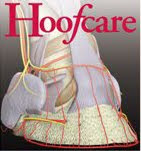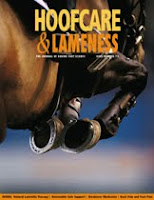 |
| Traditional sculptures in France and Belgium are "bouquet de la St Eloi". Shaped like wreaths, they are displays of a farrier's prowess at the anvil. Most are circles of horseshoes welded together but this one tells a story. Notice St Eloi is top and center. Supposedly, all these signs contain a code across the bottom that is readable only by other professional farriers. Maybe it's a message to St Eloi in case he happens to come down the street. |
Today is a feast day in many Catholic countries in Europe, especially France and Belgium. It is the day of Saint Eloi, the patron saint of farriers, veterinarians and horses. (He is sometimes called Saint Eligius, or Eloi may be spelled Aloy, in some regions.) According to tradition, no farriers shoe horses today. They gather together, instead, and have a festive time.
I will try to share some of the information I have learned about St Eloi and the holiday, as best as I have been able to get from translations and helpful French-speaking farrier friends.
 |
| A survey of art history can be done just by tracing all the famous images of the legend of St. Eloi. Here is Botticelli's intepretation, part of the altarpiece of San Marco. It can be seen in the Galleria degli Uffizi, Florence |
I first learned of St Eloi when visiting the forge of the Republican Guard stables in Paris. There was a little shrine inside the forge and I was told that Eloi was the patron saint of farriers. My hosts assured me on one day a year, farriers do not work.
In the past, it was a tradition for horsemen to give farriers tips on this day. It's a very special tradition and still taken seriously in some areas. I would love to be in France some year for this day.

According to tradition, there is a procession of farriers through towns. Take a look at what these fellows are carrying. Note the anvil on the processional banner. But the other parade prop is adorned with bits of harness and the tail of a horse. Farriers walk in a processional to wherever they are headed to eat and drink for the rest of the day.
 |
| Would you know where to look to find horseshoes in the Cathedral of Notre Dame in Paris? Just look for St. Eloi in the hall of saints and you will find them. (Wikimedia Creative Commons image) |
Here's the legend of this interesting saint:
Eloi was born in France in 588.
Eloi prided himself on his special skill of being able to shoe any horse, and of his prowess at the forge. He loved to boast about his skill and challenge others to match him.
According to Church legend, Christ, in the person of a traveler, came to the forge where Eloi was working and asked if he could use the anvil to fix a loose shoe.
 |
St. Eloi is probably the only saint who
brandishes a hammer. |
Eloi gave permission to the stranger, and was shocked to see the man twist a fore leg of the beast out of the shoulder joint, bring it into the forge, and nail on the shoe. This being done, he replaced the leg, patted the horse on the shoulder, and asked the farrier if he knew anyone who could do such a neat piece of work as that.
"Yes, I do," said the boastful Eloi. "I will do it myself."
Not to be outdone by this stranger, Eloi started to wrench the leg off a horse waiting to be shod. A terrible mess ensued, but the leg was removed. Eloi then made a very beautiful shoe and nailed it to the severed leg. The traveler applauded him for the beauty of his forgework.
But when Eloi returned to the three-legged horse, it was lying near death. How would he explain that to his customer? And why had the traveler been able to remove a leg without hurting the horse and not Eloi?
Eloi pleaded with the traveler to fix the leg he had ripped off the dying horse.
"Are you sure you are cured of pride and vanity by this mischance?" said the stranger.
"Oh, I am, I am!" cried Eloi. "I will never again, with God's help, indulge a proud thought. But why did you induce me to do this wicked thing by setting me the example?"
"My object was to root a strong vice out of your heart. Give me the leg," said the stranger. So saying, he applied the broad end of the limb to its place, tapped the animal on the shoulder, and the next moment the horse was standing up strong and uninjured.
But Eloi was alone in his forge. There was no sign of the mysterious stranger or his steed. He had witnessed a miracle, right there in the forge.
He spent the rest of his life devoted to the Church and was made a saint of all humble, hardworking people, especially workers in the metal crafts and most significantly, the farriers of the world and the horses they shoe.
 Farriers and other metal workers also used to send cards for St Eloi. I have been collecting these for years. I wish I knew more about what they symbolized. They look something like Valentines, but with lots of heavy metal and horse hooves. Maybe St Eloi was a matchmaker, too.
Farriers and other metal workers also used to send cards for St Eloi. I have been collecting these for years. I wish I knew more about what they symbolized. They look something like Valentines, but with lots of heavy metal and horse hooves. Maybe St Eloi was a matchmaker, too.
 © Fran Jurga and Hoofcare Publishing. No use without permission. All images and text protected to full extent of law. Permissions for use in other media or elsewhere on the web can be easily arranged.
© Fran Jurga and Hoofcare Publishing. No use without permission. All images and text protected to full extent of law. Permissions for use in other media or elsewhere on the web can be easily arranged.
Fran Jurga's Hoof Blog is a between-issues news service for subscribers to Hoofcare and Lameness Journal. This blog may be read online or received via a daily email through an automated delivery service.
Comments to individual posts are welcome; please click on the comment icon at the bottom of the post.






























